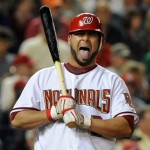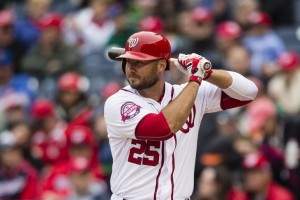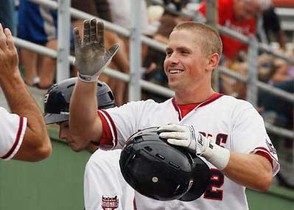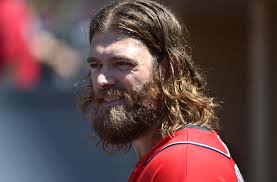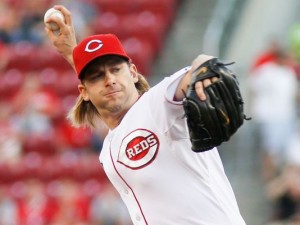
Arroyo could be a surprise NRI making the 25-man roster. Photo via google images
We discussed Non-Roster Invitees (NRI) last year (link to 2015’s post) at the behest of reader forensicane, and it was such a good topic that, upon seeing yesterday’s announcement from the various Nats beat writers (here’s James Wagner from the WP’s post), I thought I’d put up a post where we could discuss.
Reminder from last year; there were 20 NRIs; two made the 25-man roster out of spring (Dan Uggla and Clint Robinson), two others eventually got added and called up (Rafael Martin and Emmanuel Burriss) and two others were young catchers since added to the 40-man (Spencer Kieboom, Pedro Severino), so these are not throw-away players. The odds of several of these names playing a part in this team’s future is high, even past the obvious candidates (i.e. those listed at or near the top of prospect lists).
Like last year, we’ll go by position and discuss their chances for making the team, staying with the franchise, and (depending on their roster status) their future plans with the team in general (the below format is cut-n-pasted from Wagner’s post).
Catchers (1)
Discussion: Solano, the long time Nats-farm hand, returns to the fold after being released ahead of an options crunch in Nov 2014 and spending 2015 toiling for Miami’s AAA team alongside his brother. He did get 20 MLB at bats in 2015 … and went 1-for-20. He’s back, though his odds of breaking ahead of any of the four catchers we have on the roster seems very slim right now, even given the known offensive limitations of both MLB-projected catchers. Now, were one of Ramos or Lobaton go down with injury … that might open things up. Would you rather depend on one of the two rookies on the 40-man as your backup or at least go with someone like Solano, who has at least a few MLB at bats over the past few years under his belt? Neither A or B are good options, and you might think that the “Jonathan Lucroy to Washington” future plan may pick up speed at that point.
Odds of any of these NRIs making the 25-man roster: Negligible unless there’s an injury.
Future plans: Solano back to AAA once again as depth if there’s an injury; he may be flat out released if not since both Severino and Kieboom seem destined to head to AAA to split catching duties.
Infielders (4)
- RHH Jason Martinson
- RHH Brendan Ryan
- RHH Scott Sizemore
- LHH Matt Skole
Discussion: The team is quite familiar with both Martinson and Skole; both being draft picks and both being relatively close to the end of their tenure here. Martinson has quietly climbed the ranks but hit just .218 in AAA last year; what he has though is power. 21 homers and corner infield capabilities (he was a SS coming out of college but quickly moved to 3B). I view him as “Tyler Moore” insurance and the team likely has him at camp to see if he’s at all a possible option in case something bad happens. Skole has long been a personal favorite, a former Nats minor league player of the year whose promising career was derailed by a season-long injury in 2013. He took a big step back in 2015, not making the AAA team out of spring but eventually getting there mid-season. He also has power (20 combined homers last year) but from the left hand side while also playing corner infield. I view him as “Clint Robinson” insurance.
Meanwhile, both Ryan and Sizemore seemingly are competing for the second “backup utility infielder” role on this team, one that without any other moves would go to someone like Wilmer Difo or perhaps Danny Espinosa were the team to decide to go with Trea Turner from day one. I don’t see that happening; I think Difo showed he needs more seasoning, I think the team wants a veteran at short and either Sizemore or (more likely) Ryan makes this team as the 2nd utility guy.
Odds of any of these NRIs making the 25-man roster: High: I think Ryan breaks camp with the team.
Future plans: Martinson and Skole back in AAA, Sizemore may have an opt-out but may not since he was in AAA most of last year.
Outfielders (4)
- LHH Tony Campana
- RHH Chris Heisey
- RHH Reed Johnson
- LHH Logan Schafer
Discussion: Schafer was brought in presumably to compete with Matt den Dekker as a speedy CF-capable 5th outfielder type. Problem is that Schafer can’t hit: career .212 hitter with a meager career .319 slugging. Campana? Same story; the 5’8″ backup outfielder didn’t even appear in the majors last year and has just one homer in 477 career MLB appearances. den Dekker showed some promise at the end of last season and seems like he’s the first guy to get called up if/when there’s an injury in the outfield.
So lets talk about the two guys who do have some consideration. The team knows exactly what it has with Johnson: an aging scrappy veteran who can play a corner OF and be a good clubhouse presence. Sounds like Jayson Werth minus 6 inches of height and $120M of contract. I think they invited him just as saying “thanks and sorry about last year.” Meanwhile, some are talking about Heisey having a shot at this roster: I think maybe. If the team is looking to upgrade the Tyler Moore “right-handed pinch hitter off the bench” role, then Heisey is his competition. He’s somewhat accomplished; he has never really started in his career but hit 18 homers as a part-timer in Cincinnati a few years back. But his bat has been just as meager as Moore’s lately: he hit just .223 combined across several AAA levels last year. Of course, all of those figures are better than what Moore has done lately, and Heisey likely is cheaper than Moore for 2016 (Moore signed a pre-arb deal of $900k but of course could be released mid-spring training without the Nats having to pay a ton of his guaranteed salary).
The question becomes; is Heisey’s positional flexibility (he’s an OF who can play CF in a pinch while Moore can basically only play 1B) going to win out over Moore’s long tenure with the team? Maybe.
Odds of any of these NRIs making the 25-man roster: Pretty good: Heisey seems like he could beat out Moore for the RH bench bat.
Future plans: we don’t have a ton of depth at the OF position in AAA; i’m sure one or both of Schafer/Campana could stick around. Johnson could elect to retire if he doesn’t make the team at his advanced age. Heisey could stick around or could have an opt-out if he doesn’t make the squad.
Starting Pitchers (6)
- RHP Bronson Arroyo
- RHP Paolo Espino
- RHP Lucas Giolito
- RHP Taylor Hill
- LHP Aaron Laffey
- RHP Austin Voth
Discussion: Thanks to FA departures and starter conversions, the Nats now have just seven starters on their 40-man roster. Scherzer, Strasburg, Gonzalez*, Ross, Roark, Cole, Jordan. Where as last year the team could afford to send a 5-win starter to the mop-up role, this year they’re one injury from really having to answer some very serious questions. Which is probably why they have signed Bronson Arroyo honestly; despite throwing up low-to-mid 80s heat, he has remained relatively effective deep into his 30s.
In reality though, the Nats real SP depth is seen directly in the NRIs; in order Giolito, Voth and Espino. These three guys are who this team likely turns to if the injury bug really bites the projected rotation. I’m on record saying that Giolito is going to be up in 2016; might as well get him used to seeing MLB hitters (or close to it, depending on when they give him innings). In reality, nobody on this list projects to have a shot at cracking the 2016 rotation save for injury. The big question really comes down to Arroyo versus Roark for the 5th spot. Is it likely that Roark gets dumped back to the bullpen again, causing a cascading series of bullpen moves (Petit to middle relief, Treinen likely to AAA)? Not that likely but you never know, and Dusty Baker certainly goes way back with Arroyo. I think its a certainty that the NRI prospects don’t break camp with the squad … but Arroyo could have a shot.
Can’t wait for Spring Training games though to get a glimpse of Giolito on the mound…
Odds of any of these NRIs making the 25-man roster: Decent for Arroyo.
Future plans: Four of these six NRIs will form the bulk of the Syracuse rotation (Espino, Hill, Laffey, Voth), to be joined with Cole and Jordan for the core rotation in upstate NY. I’ve projected Giolito to start back in AA and prove he can dominate that level before moving up and bumping someone like Laffey or Hill from the AAA rotation. That leaves Arroyo; if he doesn’t make the team, I’m guessing he’s opting out instead of lowering himself to riding buses in AAA.
Relief Pitchers (5)
- RHP Michael Brady
- LHP Sean Burnett
- RHP Erik Davis
- RHP Nick Masset
- RHP Wander Suero
Discussion: While the 40-man roster of starters is thin (7), the Nats now have no less than thirteen (!) relievers on their 40-man roster. That’s a lot of arms. Only 7 of them are making the MLB bullpen, and for the most part you can ink in the opening day rotation by looking at the acquisitions the team has done since July of last year. So not a lot of room in the inn for NRI relievers. Davis gets the invite despite getting dumped off of the 40-man roster probably as one last ditch effort to show the MLB staff he can still pitch. Long time Nat Burnett returns to the fold coming off of a second TJ, probably given the NRI for sentimental reasons more than anything. Brady and Masset are new acquisitions (one by trade, one by MLFA) who both project to be Syracuse middle relief (where my pre-season analysis also showed a massive glut of arms), while Suero’s callup seems like an audition to be added to the 40-man roster ahead of next off season’s rule 5 draft, since Suero just finished his 6th pro season and will be exposed next December.
Odds of any of these NRIs making the 25-man roster: Nil: the Nats have way too many relievers already and none of these guys projects to be better than what we already have on the 40-man.
Future plans: Brady, Davis, Masset to AAA, Suero to AA, Burnett opts-out looking for a MLB loogy job after proving he’s healthy again on the Nats spring training meal money dime.
Summary
I think there’s a good chance of at least one and perhaps two NRIs to make the 25-man roster.





